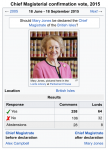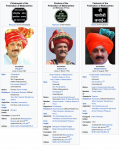
The
Constitution of the British Isles is the highest law in the British Isles. It consists of two statutes - the Charter of Liberties and Securities, and the Frame of Government. Both of these statutes originate in 1829, passed by the Convention Parliament as part of the Popular Revolution. The Charter, however, refers to a great number of prior legislation in its long preamble; though the Charter either copies verbatim these statutes' language or broadens it, these laws may be considered pseudo-constitutional in a sense. The Charter enumerates the rights of British citizens and their Parliament, while the Frame of Government describes the organization of the branches of government of the British Isles.
The Charter has never been amended, while the Frame of Government has been amended forty-three times. Initially both of these laws could be amended like ordinary laws, but since the entrenchment of the constitution in 1982 the amendment process requires a referendum of confirmation. These amendments have, over time, disestablished the church, established universal suffrage, and abolished the aristocracy. Representative of the rights-based focus of British constitutional thought is that the Charter is longer than the Frame of Government. The entirety of the Constitution is written on parchment, stored in the National Archives.
Other supplemental legislation, organizing subnational legislatures, county councils, and borough corporations, while constitutional in scope, are ordinary statutes which may be amended through Act of Parliament; as such, they are standard stuff
This constitution is one of the oldest in the world. Only a few constitutions exceed in sheer age, and this age has created a deep amount of widespread admiration. Many constitutions take many elements from it.
History
The idea of the Constitution first emerged over the course of many centuries; the beginning of British constitutional thought is usually regarded as the Magna Carta of 1215, which established a baronial assembly viewed as the first Parliament. Over time, this Parliament grew wider in its base of support, most notably growing its power under Edward III, and in strength until by the sixteenth century it came to be regarded as a powerful authority in state affairs. It is here a conception of the "constitution" emerged as a type of organic conception of law which could be found within the unwritten "common law". This "constitution", some alleged, consisted of the perfect balance of King, Lords, and Commons. By the seventeenth century, this conception strengthened, as Sir Edward Coke claimed that this "perfect balance" was rooted in the pre-Norman era and re-declared in documents such as the Magna Carta. In the eyes of this conception, all Acts of Parliament simply revealed the portion of the unwritten common law, which included constitutional law within it. Parliament passed the Petition of Right (1628) which declared a variety of rights while claiming they existed in already-ratified statutes. While this at the time wasn't a formal law, it would be regarded as such by future generations.
Over the seventeenth century King Charles I proved increasingly tyrannical; when he called a Parliament, he got into conflict with it, spiraling into the Puritan Revolution which ended with Charles I's execution in 1649 and the declaration of a republic under Parliament's authority. In this revolutionary period, very radical theories on the rights of freeborn Englishmen were enumerated, while people like Hampden and Vane became heroes of liberty. In 1653 a written constitution was issued, the Instrument of Government, which weakened Parliament and made Oliver Cromwell king in all but name; the later Humble Petition of 1657 further strengthened his position, only confirming his position as an absolutist and traitor to the constitutionalist cause. His death in 1658 caused the rapid collapse of the republic and restoration of the monarchy, resulting in the revival of the conception of the constitution as the balance of King, Lord, and Commons. Towards the end of the seventeenth century, the absolutist designs of the Stuarts resulted in conflict with Parliament. In 1679, this conflict caused the passage of the Act of Habeas Corpus, establishing security of the person. In 1688-89, it caused the overthrow of the monarchy and its replacement with that of William III. The Bill of Rights, enumerating the rights of the subject while claiming their lineage from the medieval era, was passed, along with the Toleration Act which gave limited freedom of religion to non-Anglican Protestants.
This constitutional settlement became regarded as the "perfect constitution" over the stable eighteenth century, the final completion of the organic British constitution. The American Revolution, to its supporters, was viewed as the exportation of this great constitution with adjustments for differences in society. During the French Revolution, when it became increasingly clear that the French constitutional model was to be dramatically different, the idea of the British constitution as an organic uncodified thing, immeasurably old but growing over the ages, was enumerated by traditionalist thinkers such as Burke in opposition to the codifications and constitution writing in France. Yet, those like the great Charles James Fox defended French constitutional thought, arguing that it was very similar to their (radical) view of the British constitution as a Lockean social contract. Yet, as Tories dominated British political society in the early nineteenth century, it was the extremely traditionalist model of the constitution which maintained political dominance. As Radical organization grew in the 1810s and 20s, it was suppressed, and in 1827, the government was overthrown.
A Convention Parliament was called, and by 1829 it finally wrote a Charter expanding upon the rights violated by the previous government as well as a Frame of Government establishing the radical conception of the Constitution into law. The preamble to the Charter included a very long reference to old legislation, which was aimed at showing that the Convention Parliament didn't want to import foreign French constitutional models but instead purify the existing constitution, adjust it for modern society, and prevent it from being overthrown again. It was aimed at showing that its makers were patriots, in full claim of their rights as freeborn Britons won over the ages. Yet, during the chaotic Headless State period, it was the older organic conception of the constitution which continually emerged. Orangemen and Scarletmen, and traditionalist opponents of the new regime, alleged that indeed the Charter and Frame of Government did destroy the true British constitution of the ages and replace it with an evil "Jacobin" constitution. Calls to return to the "Magna Charta, the true Constitution of this Isle" were commonplace. These calls only really dissipated as the new regime grew entrenched and secure. The idea of the Constitution as within the mysterious unwritten "common law" was later overthrown after the writing of the various law codes by the Brougham Commission, which codified large amounts of British law in five codes; even as this was attacked, it supplanted the idea of the common law.
Over time, during the Lawson administration, its stability enabled amendments to the constitution, expanding suffrage and disestablishing the church. Yet more elements of the "ancient constitution" were amended out of existence; the House of Lords was made partially elective, and suffrage was made universal under the Martineau administration. With the passage of time, the Charter and Frame of Government looked ancient in its own right and love for them grew across the entire political spectrum; it became less important to look beyond them. These two acts came to be regarded as a constitution in their own right, founded in 1829 and much superior to anything which had existed before. Ultimately, its perceived violation led to its entrenchment in 1982; now the Houses of Parliament could only propose amendments which required a referendum to be ratified. Since then, constitutional amendments have become relatively minor in scope, but despite that referenda over them are often complicated affairs which threaten governments.

























